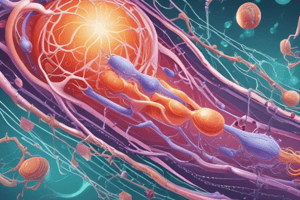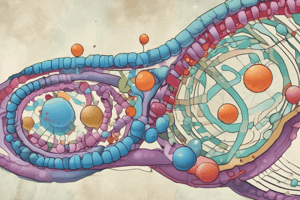Podcast
Questions and Answers
How do cells make proteins?
How do cells make proteins?
The cell makes proteins based on a process called protein synthesis.
What happens during protein synthesis?
What happens during protein synthesis?
During protein synthesis, the cell uses information from a gene on a chromosome to produce a specific protein.
What do proteins do?
What do proteins do?
Proteins help determine the size, shape, color, and other traits of an organism by triggering cellular processes.
Describe the structure of a protein.
Describe the structure of a protein.
Where does protein synthesis occur?
Where does protein synthesis occur?
What is the function of mRNA?
What is the function of mRNA?
What is the function of tRNA?
What is the function of tRNA?
What is the difference between RNA and DNA?
What is the difference between RNA and DNA?
How is the process of making mRNA different than DNA replication?
How is the process of making mRNA different than DNA replication?
Where does the mRNA go after it is made?
Where does the mRNA go after it is made?
How is tRNA involved in the making of proteins?
How is tRNA involved in the making of proteins?
What is the first step of protein synthesis?
What is the first step of protein synthesis?
What occurs during the second step of protein synthesis?
What occurs during the second step of protein synthesis?
What happens during the third step of protein synthesis?
What happens during the third step of protein synthesis?
What occurs in the fourth step of protein synthesis?
What occurs in the fourth step of protein synthesis?
What is the final step of protein synthesis?
What is the final step of protein synthesis?
Flashcards are hidden until you start studying
Study Notes
Protein Synthesis Overview
- Cells create proteins through a process known as protein synthesis.
- Protein synthesis relies on genetic information found in genes on chromosomes.
Role of Proteins
- Proteins influence an organism's traits such as size, shape, and color.
- They initiate various cellular processes essential for function and growth.
Structure of Proteins
- Proteins are composed of amino acids, of which there are twenty types.
- Unique combinations of amino acids can produce thousands of different proteins.
Location of Protein Synthesis
- Protein synthesis primarily occurs in the cytoplasm, outside the nucleus of the cell.
Messenger RNA (mRNA)
- mRNA is responsible for copying genetic information from DNA and transporting it to the ribosome.
- After synthesis, mRNA migrates from the nucleus to the cytoplasm.
Transfer RNA (tRNA)
- tRNA serves to transport specific amino acids to the ribosome and facilitates their addition to the growing protein chain.
Differences Between RNA and DNA
- RNA is single-stranded, while DNA is double-stranded.
- RNA contains uracil instead of thymine, differentiating it from DNA, which contains thymine.
- RNA and DNA have distinct sugar components.
mRNA Synthesis vs. DNA Replication
- mRNA synthesis resembles DNA replication in base pairing (cytosine with guanine).
- In mRNA, uracil pairs with adenine instead of thymine.
Steps of Protein Synthesis
First Step
- mRNA is generated in the nucleus after DNA unzips between base pairs.
- RNA bases pair with DNA bases, with adenine pairing with uracil.
Second Step
- Ribosomes latch onto the mRNA in the cytoplasm, interpreting its code to guide protein formation.
Third Step
- tRNA molecules bind to corresponding codons on the mRNA, reading the message and bringing amino acids to the ribosome.
Fourth Step
- Amino acids are sequentially linked within the ribosome, forming a polypeptide chain based on the mRNA's codon sequence.
Fifth Step
- The protein chain expands as the ribosome moves along mRNA, and synthesis continues until it encounters a stop codon, signaling the release of the completed protein.
Studying That Suits You
Use AI to generate personalized quizzes and flashcards to suit your learning preferences.




